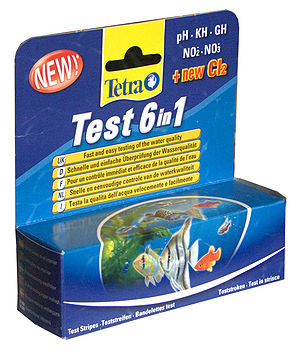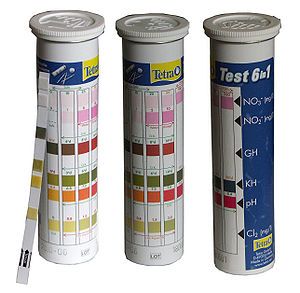Tetra Test 6in1
Contents
Product Name[edit]
Test 6in1
Manufacturer[edit]
Tetra GmbH - Germany
Product Description[edit]
25 Nessler type dry pad test strips contained in an aluminium metal sealed tube with a push on lid.
It measures :
- Nitrate (NO3) 0 to 250 mg/l in 6 stages (inc. zero)
- Nitrite (No2) 0 to 10 mg/l in 4 stages (inc. zero)
- GH 0 to 16°d in 4 stages (inc. zero)
- KH 0 to 20°d in 6 stages (inc. zero)
- pH 6.4 to 8.4 in 6 stages (inc. zero)
and
- Chlorine (Cl2) 0 to 3 mg/l in 4 stages (inc. zero)
Usage[edit]
You simply dip the stick into the water and swirl it about for 5 seconds, remove and shake off excess water and wait for approximately 60 seconds and compare colours on stick to side of tube.
Date Stamp[edit]
This items uses chemicals and has a finite shelf life. The metal tube when bought in 2008-08-29 had a sealed date stamp of 2010-06 which is almost 2 years.
- Once the seal on the tube is broken the strips will remain effective for 5–6 months if the strips are kept in the tube at room temperature and away from direct sunlight. Less if kept at around 25-30°C (77-86°F) .[1]
Retail Cost[edit]
Approximately £11.95
User Review[edit]
I've used Tetra 5in1 tube strips for a couple of years and this product is much the same. So I'll highlight the differences.
- It now does free chlorine.
- This means you can test for chlorine levels and indirectly for the presence of chloramine in your tap water (if your tap water supplier uses chloramine then by testing for a small level of chlorine it will show up as a 'above zero' level.
- The GH colour bands have been changed from 'green to pink' to 'dark green to dark orange'.
- Each scale now has on it a "OK" or "Water change" marked line to show beginners what levels are not safe. This is a good positive change by Tetra as it makes it harder for the user to get it wrong! The Chlorine scale has a "Use AquaSafe" marking, which basically means use a water conditioner which will neutralise Chlorine.
For those of us who get chloramine put into their tap water, an increasing large number of us it seems every year, you may be wondering how useful this chlorine level is? Well the standard test for chloramine is to measure total chlorine and free chlorine and then subtract the free chlorine measurement. This is your level of chloramine. QED, any level of free chlorine indicates that there may be chloramine in the water and you need to use a chloramine removing water conditioner.[2]
Useful points[edit]
- Ensure the pads get time to absorb the water. 5 seconds is plenty.
- The test strip has 3 protective bands between the groups of pads to prevent water drips from one pad contaminating the lower ones as you remove it from the water. So best to give the strip a flip of the wrist to quickly remove excess water.
- Keep the strips in the tube with the top on and away from the sun and they'll last longer. While these Nessler type kits are not super-accurate, they will lose their effectiveness over time and you don't want a seemingly good reading of 25 mg/l of nitrate to be in reality 100+mg/l!
- The readings only remain valid for about 2 minutes after the initial 60 seconds are up. So don't forget you've done the reading or you've wasted ~48 pence. I use an electronic countdown timer!
- You'll be better able to judge the colour on the pads if you let sunlight fall on the readings. Indoor lighting may make it harder to read subtle differences
- I've read of people slicing these strips down the middle to double the number of tests you get. Cute idea.
- Look for indications that the stick is past its usable state: The NO3 or NO2 squares turn yellow when dipped into water. These read false low levels of nitrate or nitrite when old. You can't trust them. See above for lifetime period once opened.
--Quatermass 20:18, 20 August 2009 (UTC)
References[edit]
- ↑ Tetra Help desk - Dave Hulse B.Sc. (Hons), M.Sc.
- ↑ Free Chlorine, Bound Chlorine, chloramine and Total Chlorine PDF file by [http://ibtbiomed.com/tech_corner/ Integrated Biomedical Technology Bulletins

